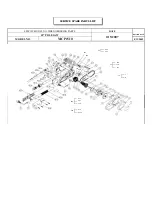
Operators manual for the Pentruder 6-12HF and Pentpak HF-power pack – Original instructions
Page
20
How to fit a blade on a flush cutting flange:
The Pentruder 6-12HF is a powerful machine. This means the blades which are fitted for flush
cutting must be properly fixed to the machine. When a blade is fitted to a flush cutting flange, it is
very important for safety to respect the following instructions:
Centre bore:
The saw blade should have a hole with diameter 60 mm –0 +0.1 mm,
and be free from cracks, dents, burrs and dirt.
Clamping:
The blade is fixed with 6 countersunk screws. The bolt circle and size
varies depending on market and supplier of the blade.
Bolt circle:
In Europe 110 and 130 mm bolt circle is commonly used with either M10
or M8 screws.
Screw quality and
torquing of screws:
The blade must be clamped with countersunk screws from Unbrako and
be of quality 10.9. The nuts must be of type “Nyloc” and the fasteners
must be torqued with a torque wrench to 35 Nm for M8 screws and to 50
Nm for M10 and 3/8” screws. The threads must be lubricated with grease
or oil.
Warning! The saw blade must always be fitted correctly to avoid danger. The instructions
given above must always be followed to avoid faulty mounting of the blade, which in turn
can cause serious personal injury or death.
Warning! It is important to be aware of the fact that when a flush cutting blade is used, the
blade is clamped merely by the six countersunk screws, nothing else.
Warning! Flush cutting is a questionable method from a safety point of view. As flush
cutting requires use of a “half” blade guard, the operator should be aware that the level of
safety never can be comparable to normal cutting when a full blade guard is used. This is a
potentially dangerous method and should be treated likewise.
Important! The blade must have a bolt circle where the holes are spaced on an even and
exact pitch to prevent unequal load distribution on the screws, blade and flange. Look out
for cracks around the counter sunk holes in the blade. Some blades are prone to crack and
if that happens, it is potentially a very dangerous situation which can lead to fatal accidents.
















































